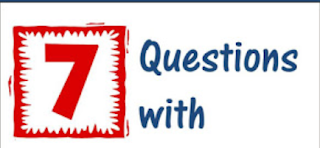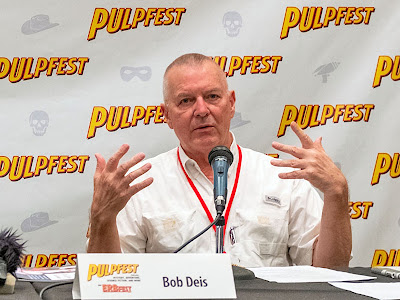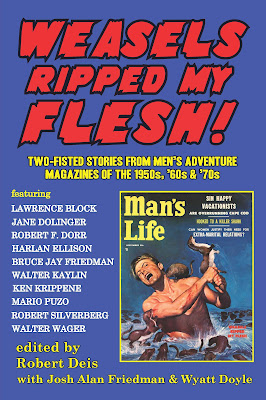Robert Deis is the Editor of the Men’s Adventure Library book series, the Men's Adventure Quarterly magazine and MensPulpMags.com . In the magazine and in many books, Deis edits reprints of original stories and artwork from the Men's Adventure magazines popular from the 1940s to the 1970s. Catering to a male audience, these magazines commonly featured action/adventure, crime and war stories, exposés, exotic travel yarns, and animal attack stories, pinup photos, and eye-grabbing cover and interior artwork. The most recently published collection is titled Atomic Werewolves and Man-Eating Plants.
1. How and when did you get hooked on history?
I’ve been a history buff since the 1950s, when I was a kid growing up in Dayton, Ohio, I
loved TV shows and movies that were set in the past; everything from Westerns and
Walt Disney’s Davy Crockett series to sword-and-sandal movies set in ancient Greece
and Rome. After I learned to read, I started reading history books and historical novels
geared toward young readers. As a teen I was a huge fan of Civil War history, which
was big then because of the Civil War Centennial, which led me to read things like
Bruce Catton’s Civil War trilogy. I also loved American Heritage magazine and National
Geographic. In college at Ohio State University, I majored in anthropology and was
especially interested in American Indian history and culture. My interest in history has
continued since then.
2. What role does history play or has it played in your personal life?
After college, I moved to Maine, where I spent the first part of my career as an adult
working for the Maine state government. On the side, I started writing articles about
Maine history, wildlife and environmental issues for magazines like DownEast and
Yankee. My writing skills later got me various types of jobs as a copywriter, leading to a
long a four-decade career writing print materials, TV ads, and other things for national
firm that manages ballot measure campaigns. About 20 years ago, I read a couple of
books about vintage men’s adventure magazines published in the 1950s, 1960s and
1970s. I started collecting those mags—called MAMS, for short—and fell in love with
the stories and artwork. Over time, I put together what is now one of the world’s largest
collections of MAMs, maybe the largest. Around 2012, I started writing a blog about
them (MensPulpMags.com). That soon led me to start co-editing books and a magazine
that focus on reprinting MAM stories and art. Some of my books have a lot to do with
history, such as the book A Handful of Hell, which collects war and adventure stories
written by Robert F. Dorr, who started out writing for men’s adventure magazines, then
became one of America’s top military aviation historians.
3. How does history play a part of your professional life/career?
It didn’t play much of a role in my primary adult career as a campaign consultant and
writer. However, it did play a role in the freelance magazine articles I wrote. And,
nowadays it plays a role in the projects I developed with fellow MAM fans I met as a
result of my blog. One of them, Wyatt Doyle, heads up the New Texture indie publishing
company. Starting in 2013, he and I launched a series of books reprinting stories and
artwork from MAMs, called the Men’s Adventure Library series. In those books, we write
introductions about the writers, artists and historical events related to the stories and
artwork. Many of them involve historical events, so we often research and write about
how much fact or fiction there is in the stories. We also do research about MAM writers,
artists and publishing companies. A couple of years ago, I launched a magazine that
reprints MAM stories and artwork with Bill Cunningham, head of the Pulp 2.0 publishing
company. It’s called the Men’s Adventure Quarterly. Like the books I co-edit, I write
intros for the stories we reprint in the MAQ. Nowadays, though I still do some campaign
consulting, I primarily spend my time on my books and magazine publishing projects
and, as a result, have basically become what you might call a pop culture historian.
4. Why is studying/knowing history important?
On a personal level, I think it’s crucial to anyone who really wants to understand what’s
going on in our world today and have an informed perspective that’s based on more
than simplistic prejudices. I’m shocked at how little many people know about history and
how easily that leads to them have opinions that are based more on political
propaganda than facts.
5. What is your favorite period or aspect of history to learn about and why?
As a kid I was especially interested in American history from the 1600s to the early
1900s involving frontiersmen, cowboys and Indians. I still am, though now I read as
much or more about 20th century history, especially World War II, the Korean War, and
the Vietnam War, since they play a role in many of the stories I write introductions for.
6. How did men’s adventure magazines become a part of your life?
When I was a kid and a teenager in the ‘50s and ‘60s, my father read some of the most
popular MAMs, like True and Argosy, but I didn’t pay much attention to them back then
and the genre faded away entirely by 1980. I really got into them because of two books
about them published in mid-2000s, Men's Adventure Magazines: In Postwar America
and It’s A Man's World: Men's Adventure Magazines, The Postwar Pulps. I was blown
away by the artwork, done by some of the greatest illustration artist of the 20th Century.
Artists like Mort Künstler, who later became an illustrator for National Geographic and,
starting in the 1980s, became known as America’s premier Civil War artist. As I
collected the magazines, I found them to be full of a fascinating cornucopia of both
fiction yarns and non-fiction articles that are fun to read both as entertainment and
interesting as windows into American culture in the ‘50s, ‘60s and ‘70s.
7. What do the men’s adventure magazines reveal to us about their era, and what
is their significance in history?
During the decades when they were published, men’s adventure magazines were read
by tens of millions of American men, especially veterans of WWII and the Korean War.
So, they are significant from both sociological and publishing history perspectives. They
are very significant in the realm of illustration art, since they were a primary market for
many illustration artists at a time when mainstream magazines were switching to
photographs rather than artwork for their covers and interior illustrations. They are also
significant in the realm of pulp fiction, since they are descendants of the pulp magazines
that were popular between the early 1900s and World War II and have many
connections to the writers, artists and publishers involved in the paperback industry that
emerged and exploded after WWII. They also have significance in terms of sociological
history. They provide insights into the kinds of stories read by men in the ‘50s, ‘60s and
‘70s and the worldview those men had. Because they are of their time, many aspects of
MAMs now seem sexist, racist, and ethnocentric. But that was true of most mid-20th
century American media and culture. To me, the best reasons to read old MAM stories
are that many of the fiction stories are just plain fun-to-read action/adventure yarns, the
cover and interior artwork is great, and many of the non-fiction articles involve historic
events seen through the prism of that era.








%20&%20Bob%20Deis%20(r)%20at%20the%20PulpFest%202023%20Convention%20in%20Pittsburgh.jpg)
Very interesting, Bob!
ReplyDelete